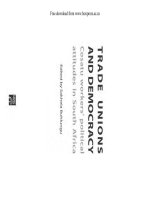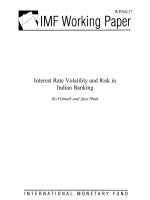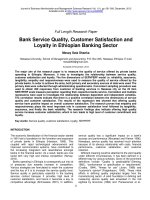Trade, investment and competition in international banking
Bạn đang xem bản rút gọn của tài liệu. Xem và tải ngay bản đầy đủ của tài liệu tại đây (565.22 KB, 208 trang )
Trade, Investment and
Competition in
International Banking
Aidan O’Connor
Trade, Investment and Competition in International Banking
This page intentionally left blank
Trade, Investment and
Competition in International
Banking
Aidan O’Connor
© Aidan O’Connor 2005
All rights reserved. No reproduction, copy or transmission of this
publication may be made without written permission.
No paragraph of this publication may be reproduced, copied or
transmitted save with written permission or in accordance with
the provisions of the Copyright, Designs and Patents Act 1988, or
under the terms of any licence permitting limited copying issued
by the Copyright Licensing Agency, 90 Tottenham Court Road,
London W1T 4LP.
Any person who does any unauthorised act in relation to this
publication may be liable to criminal prosecution and civil claims
for damages.
The author has asserted his right to be identified as the author
of this work in accordance with the Copyright, Designs and
Patents Act 1988.
First published 2005 by
PALGRAVE MACMILLAN
Houndmills, Basingstoke, Hampshire RG21 6XS and
175 Fifth Avenue, New York, N. Y. 10010
Companies and representatives throughout the world
PALGRAVE MACMILLAN is the global academic imprint of the
Palgrave Macmillan division of St. Martin’s Press, LLC and of
Palgrave Macmillan Ltd.
Macmillan® is a registered trademark in the United States, United
Kingdom and other countries. Palgrave is a registered trademark in
the European Union and other countries.
ISBN-13: 978–1–4039–4132–9 hardback
ISBN-10: 1–4039–4132–7
hardback
This book is printed on paper suitable for recycling and made
from fully managed and sustained forest sources.
A catalogue record for this book is available from the British
Library.
Library of Congress Cataloging-in-Publication Data
O’Connor, Aidan, 1955–
Trade, investment, and competition in international banking / by
Aidan O’Connor.
p. cm.
Includes bibliographical references and index.
ISBN 1–4039–4132–7
1. Banks and banking, International. 2. International finance.
I. Title.
HG3881.O268 2005
332.1′5–dc22
10
14
9
13
8
12
7
11
6
10
2005047293
5
09
4
08
3
07
2
06
1
05
Printed and bound in Great Britain by
Antony Rowe Ltd, Chippenham and Eastbourne
To the memory of my father
and
For my mother
This page intentionally left blank
Contents
List of Tables
x
List of Figures
xiii
Acknowledgements
xiv
Introduction
1
Part I The Evolution and Development of International
Banking
3
Chapter 1
International Banking in the Pre-Modern and
Modern Banking Eras
Developments in northern Italy
Northern Europe
Amsterdam and the onset of modern banking
The United Kingdom emerges as the leading
creditor country
France as a competitor creditor country
Germany finances industrial development
Switzerland’s internationally active banks and
capital exports
European banking systems and national
economies in the 19th century
The United States and the shift in economic
power and the centre of international finance
Japan’s modernisation and internationalisation
International financial centres in the late
19th century and early 20th century
The internationalisation of banks from the
19th century to the mid 20th century
Consortium banks
The onset of contemporary banking
vii
5
5
6
8
9
12
14
14
15
18
21
23
27
30
32
viii Contents
Part II The Characteristics of and Influences on
Contemporary International Banking
37
Chapter 2
Contemporary International Banking Markets
39
International money and capital markets
The euromarkets
The foreign exchange market
Derivative financial products
The gold market in London
Competition between intermediaries
The influence of institutional investors
Capital flows
42
43
47
50
56
58
61
64
Regulation, Trade Agreements, Consolidation
and Integration in International Banking
70
Chapter 3
Deregulation of financial markets
Capital adequacy
Liberalisation, international trade agreements
and international banking
Concentration in domestic banking markets
Cross-border mergers and acquisitions among
financial firms
Electronic banking
Part III
Chapter 4
Chapter 5
71
73
75
80
82
91
Internationally Traded Banking Services
95
Trade Theories and International Banking
97
Theories of international trade
Theories of international banking
International financial centres
99
102
107
The Scope of International Banking, Business
Activities and Markets
117
International and foreign claims
International and multinational banking
Types of banks
Organisation type of foreign bank offices
Organisation structure and business description
of multinational banks
International banking and securities markets
118
120
125
130
134
145
Contents ix
Part IV Competitive Advantage in International
Banking
149
Chapter 6
The Leading International Banks
151
International banking market and product reach
Competitive advantage in services among
international banks
151
Part V
The Evolving International Banking Industry
167
Chapter 7
Trends and Strategies of International Banks
169
153
Notes
176
Index
185
List of Tables
Table 1.1
Table 1.2
Table 1.3
Table 1.4
Table 1.5
Table 1.6
Table 1.7
Table 2.1
Table 2.2
Table 2.3
Table 2.4
Table 2.5
Table 2.6
Table 2.7
Table 2.8
Table 2.9
Table 2.10
Table 2.11
Table 2.12
Table 2.13
Ratio of Bank Offices to Total Population
Bank Assets as a Proportion of National Income
and National Wealth
Financial Assets to Tangible Assets Multiples of
Gross National Product
Foreign Deposits in London, Paris and Berlin 1913
Net Foreign Private Long Term Assets 1855–1913
Gross Nominal Value of Capital Invested Abroad
1914–1938
Estimated Stock of Accumulated Foreign Direct
Investment 1938–1960
Global Foreign Exchange Market Turnover
1995–2004
Geographical Distribution of Foreign Exchange
Market Turnover 1998–2004
Leading Banks in Foreign Exchange 2004
Leading Derivative Dealers 2000
Global Over-the-Counter Derivatives Market 2003
Notional Amounts Outstanding and Gross
Market Values by Risk Category
Global Over-the-Counter Derivatives Market 2003
Notional Amounts Outstanding by Risk Category
and Instrument
Global Exchange Traded Futures and Options
Derivatives 2003 Amounts Outstanding by Risk
Category, Notional Amount, Instrument and
Location
Financial Assets of Institutional Investors 2001
Financial Assets of Institutional Investors by Type
of Institutional Investor 2001
Portfolio Composition of Institutional Investors 2001
Total Financial Assets by Type of Institutional
Investor 1993–2001
Individuals’ Claims on Institutional Investors 2001
Current Account Balances 1991–2004
x
16
17
18
25
33
33
34
48
49
49
53
54
55
56
61
62
62
63
63
64
List of Tables xi
Table 2.14
Table 2.15
Table 2.16
Table 2.17
Table 3.1
Table 3.2
Table 3.3
Table 3.4
Table 3.5
Table 3.6
Table 4.1
Table 4.2
Table 4.3
Table 4.4
Table 4.5
Table 4.6
Table 4.7
Table 5.1
Table 5.2
Table 5.3
Table 5.4
Table 5.5
Financial Flows to Developing Countries
1956–1985
Net Private and Official Capital Flows to
Developing and Transition Economies 2000–2003
Percentage of Foreign Bank Affiliates’ Assets to
Total Assets 2001
Foreign Bank Ownership in Emerging Economies 2001
Concentration in Banking 2003
Cross-Border Alliances in Banking and Financial
Services in the European Union 1987–1993
Number and Value of Mergers and Acquisitions
between Banks 1990–2001
Aggregate Number of Mergers and Acquisitions
between Commercial Banks, Securities Firms
and Insurance Firms 1985–2000
Financial Firms’ Cross-border Mergers and
Acquisitions 1985–2000
Leading Banks in Retail and Corporate Internet
Banking 2004
Banking Services in Europe to Affiliates of Foreign
Firms
Best Treasury and Cash Management Banks 2004
The Most Important Criteria for a Financial Centre and
Factors for the Leadership of London in Europe
Foreign Banks in London 2004 and New York
2003
Personnel and Office Occupancy Expenses in
Financial Centres 2004
Foreign Banks’ Business Activities in London 2004
Selected Domestic Assets of New York Offices of
Foreign Banks 2004
Favoured Type of Office of Foreign Banks in London
2004 and New York 2003
International Banking and Securities Markets
2003
International Banking Market 2003
International Securities Markets by Nationality of
Issuer 2003
International Securities Markets by Type of Issue
2003
65
66
68
69
81
83
85
85
87
93
105
106
110
111
112
113
114
134
145
146
146
147
xii List of Tables
Table 5.6
Table 6.1
Table 6.2
Table 6.3
Table 6.4
Table 6.5
Table 6.6
Table 6.7
Table 6.8
Table 6.9
Table 6.10
Table 6.11
Profitability of Commercial Banks 2003
Proportion of Banks in the Leading 1000 World
Banks by Origin 2004
Banks Ranked in the Leading 50 by Assets or Tier
1 Capital 2004
Banks Ranked in the Leading 50 by Assets or Tier
1 Capital and Range of Assets by Country of
Origin 2004
Banks Ranked in Leading 50 and 1000 Banks by
Assets or Tier 1 Capital Ranked by Origin,
Number and Proportion 2004
Banks Ranked by Proportion of Foreign Assets and
Total Assets 2004
Leading Banks by Business Activity 2004
Frequency of Banks Ranked among the Best Banks
by Business Activity 2004
Banks Ranked by 30% or More of Foreign Assets
and in Three or More Business Activities 2004
Leading 24 Banks in International Banking 2004
Leading Banks through Recent Mergers and
Acquisitions
Best Bank in Business Activities 2004
147
154
154
156
157
158
160
161
162
162
163
164
List of Figures
Figure 2.1 International Money and Capital Markets
Figure 2.2 Derivative Contracts, Instruments and Risk
Category Markets
Figure 2.3 Alternative Sources of Funding among Private
Sector Units
Figure 5.1 International and Foreign Claims of Banks
Figure 5.2 Classification of Domestic, Foreign and Euro
Bonds
Figure 5.3 Features of Domestic, Foreign and Euro Bonds
Figure 5.4 Typology of International Banking
Figure 5.5 Typology of Trade in Banking Services and Foreign
Investment by Banks
Figure 5.6 Typology of International Banks’ Principal
Customers and Banking Activities
Figure 5.7 Country Characteristics, Banking Market Dynamics
and Bank Advantages Affecting Bank
Internationalisation
Figure 5.8 Relative Advantage of Alternative Foreign Offices
Figure 6.1 Market and Product Reach of Banks
Figure 6.2 Strategic Groups of Banks Competing in National
Banking Markets
xiii
42
51
60
119
119
120
121
124
129
130
133
152
152
Acknowledgements
Writing a book depends on many people and organisations for its completion. While those who assisted me are too numerous to mention
I must acknowledge the support of the many scholars and organisations that supplied books, journals, articles or research papers.
In particular, I must acknowledge the support of the various academic libraries, and the many helpful librarians, who allowed me access
to their resources. The generosity of all astounded me.
I am most grateful to several people at Palgrave, to Rebecca Pash,
Assistant Editor for her efficiency during the administration of the
project, to Stephen Rutt, Publishing Director, for his prompt response to
my proposal which encouraged me enormously, and finally to Jacky
Kippenberger, Commissioning Editor, for her patience and advice in
managing the process.
Aidan O’Connor
France
July 2005
xiv
Introduction
There are three distinct eras in the development of financial systems.
These are the pre-modern era up to the early 18th century, the modern
era from the early 18th century to the mid 20th century and thereafter
the contemporary era, an extension of modern banking and which
may be subdivided into the Bretton Woods era 1945–1973 and the
post-Bretton Woods or floating exchange rates era.
The beginning of modern financial systems is considered as the early
18th century in western Europe, the late 18th century in the rest of
Europe and the Americas, the 19th century in south and east Asia,
Australia and Oceania and the early 20th century in sub-Saharan
Africa. A reason for such a lag in the development of systems between
regions is due to the criteria used in defining a modern financial
system. The features of a modern financial system are considered as a
monetised sector, fiduciary money issued either by a central bank or by
banks acting in such a capacity, and limited liability private firms.1
The international financial system comprises private banks, public
monetary authorities and international financial institutions. The
focus is on private international banks, that is, commercial, investment
and universal banks.
The development and evolution of international banking includes
structural developments, in terms of size, scope, products and processes, in terms of the legal and regulatory systems and also in terms of
the business activities of banks.
The central theme is trade and investment in the international
banking industry, the main aspects of which are cross-border trade in
banking services, foreign direct investment by banks, international
financial centres, capital movements and competition between banks.
This theme is treated from evolutionary and theoretical aspects, as well
1
2 Trade, Investment and Competition in International Banking
as, from the competitive aspects of the leading international banks.
The international banking industry is treated from the perspective of
regulations, markets and banks and their inter-relations and the
increased competition and internationalisation of the industry.
The first part traces the evolution and development of international banking through the development of national banking industries, international financial centres and international banks in the
pre-modern banking era and in the modern era up to the 1950s. This
historical overview is primarily country based to reflect the nature of
the development of banking in different countries and the evolution
and development of international financial centres in specific locations. While of necessity selective it is a representative overview of
the evolution of banking.
The second part focuses on the characteristics and influences on
international banking in the contemporary banking era. There is an
emphasis on innovations in markets, products and processes and their
rapid and widespread diffusion, thereby accelerating the integration of
international banking. Due to the pivotal role of banking in an
economy, banks have been highly regulated, thus shaping national
banking and the ability of banks to operate internationally. There is
also a focus on de-regulation and liberalisation of banking markets,
mergers and acquisitions and capital movements. The influence of
international trade agreements and international bank regulation is
also outlined.
The third part outlines the main theories of international trade
and foreign direct investment and their application to cross-border
trade in banking services and to foreign direct investment by banks.
There is also an analysis of international financial centres and the
business activities of banks in these centres. This part also classifies
contemporary international banking by type of bank, service, and
customer.
Competitive advantage by international banks is the theme of the
fourth part and outlines the organisation and activities of selected
international banks and analyses the competitive aspects of international banks to ascertain the leading banks based on the quality of
their services and international orientation.
Part five reviews the evolution, the current state of international
banking and the strategies of international banks.
Part I
The Evolution and Development of
International Banking
This page intentionally left blank
1
International Banking in the Pre-Modern
and Modern Banking Eras
Trade was centred in fairs in medieval times and it was there that moneychanging type banking services commenced. Fairs were held at regular
intervals and developed as meeting places for merchants from many
regions. They differed from markets as they were held less frequently,
although regularly, and continued for a few weeks. These fairs were often
centred on wholesale trade between merchants and developed into
financial centres where bankers established branches.
This is the earliest form of international banking and the trade fair
the earliest form of financial centre. These centres emerged in places
that were strategically situated on the main trade routes and flourished
due to their local patronage and to the protection provided for foreigners. Their emergence was associated with trade, their development
associated with innovation and advances in financial systems and their
decline with politics, especially in the pre-modern and the early
modern banking eras.
Developments in northern Italy
North Italian bankers were the earliest bankers in the modern sense,
the term ‘bank’ deriving from banca, the Italian for bench. North
Italian cities such as Florence, Lucca, Siena, Genoa and Venice flourished in oriental trade between the 12th and 15th centuries. Moneychanging type of banking existed because of the many different
denominations of coins that circulated freely. As these coins contained
a specific amount of precious metal they were easily convertible.
Banking also developed from merchants who financed foreign trade.
The emergence of merchant bankers occurred in the 13th century
when the bill of exchange was developed. This was one of the most
5
6 Trade, Investment and Competition in International Banking
influential innovations in banking and allowed merchants, instead of
accompanying goods to fairs and markets themselves, to send representatives or use local correspondents. The merchant banks of Florence
and Lucca were to the forefront in its application.1 With its widespread
use in Europe, the bill of exchange became the main form of trade
finance.
Representative offices soon emerged in the leading trade centres and
these later developed into branches. It was the banking dynasties of
northern Italy which were influential up until the 16th century that
were to the forefront in transforming banks from trade fair representative offices to those with permanent branches. These banks had branches
throughout Europe and were also sources of information on trade conditions for the bankers. By 1335, the Pedruzzi bankers, had branches
throughout Italy and Europe, with five agents in England, four in France,
four in Flanders, four at Avignon and 11 in the Kingdom of Naples.
Outside shareholders of the Pedruzzi bank were by this time in the
majority.2 Branches were mostly managed by relatives and their capital
was composed of the partners’ own funds although some were managed
by agents. The Florentine, Bardi and Pedruzzi bankers managed their
bank as a joint stock company.3 These bankers began to lend to sovereigns, many of whom were unable or unwilling to repay, and this led to
the closure of some of the banks.
The trade fairs were not without political influence. The fair at
Geneva emerged when mainly Italian merchants and bankers moved
there. Louis XI of France forbade French merchants from attending this
fair and an alternative fair was established at Lyon. With the transfer of
some of the merchants and bankers from Geneva to Lyon in 1465, it
became the leading financial centre in France until Paris assumed that
role. The Genoans were prohibited from attending the fair at Lyon and
so established a fair at Besançon, a free city, and in the 16th century
this was an internationally important financial centre. Fairs declined in
importance by the 17th century.4
Northern Europe
Bruges was one of the most important money markets in northwestern Europe in the 14th and 15th centuries and north Italian
bankers established branches there. A buerse, or the current term
‘bourse’, was established there, the term originating from that of the
Van der Buerse inn.5 Between the 14th and 16th centuries other
important financial centres developed in Europe, such as Augsburg
International Banking in the Pre-Modern and Modern Banking Eras 7
and Antwerp. Frankfurt was a leading financial centre in central
Europe due to its links with the Lyon, Besançon and Piacenza fairs.
The decline of northern Italy as the most important centre of banking
commenced with the decline of the Florentine bankers in the early
16th century and continued with the decline of Genoa as a trading
centre a century later. One of the reasons for this was the opening of
new sea routes to the east around the Cape of Good Hope with the sea
faring Dutch and Portuguese becoming the leading traders with the
orient. The Atlantic economy also increasingly gained importance for
these traders, as well as for the English.
South Germany, especially the city of Augsburg, which was easily
accessible from northern Italy, became a leading banking centre and
the Fuggers, the Welsers and the Hochstetters were the most important
bankers in the 16th century. They were involved in international commodity trade, foreign exchange and sovereign lending.6 The Fuggers
financed the House of Hapsburg and helped ensure the election of
Charles V as Holy Roman Emperor. They had branches throughout
Europe like their northern Italian counterparts before them. Also like
some of the north Italian bankers, sovereign lending in the 1550s
eventually brought about their closure due to defaults on loans.
Augsburg as a centre of banking did not last very long but it had a
lasting influence on the banking industry as banks there developed the
concept of financial intermediation by accepting deposits for sovereign
lending.7
Antwerp emerged as an international financial centre in the late 15th
and early 16th centuries and was also a leading centre for international
trade in the first half of the 16th century. The endorsing of bills of
exchange began there on a large scale in 1600, although there had
been endorsing on a limited scale in northern Italy since the 14th
century. This rendered the instrument negotiable. Another development was the discounting of bills of exchange thereby making it possible to sell a claim.8 This innovation later led to payments with paper
banknotes. A bourse was opened there in 1531. It was in Antwerp that
the Spanish raised finance and the Portuguese sold their produce. The
English, who always had strong trade links with this area, and all
the major Augsburg bankers as well as the Genoan bankers, were represented there. It was the credit surpluses, the volume of international
trade and the accessibility to capital through a bourse that led to
Antwerp becoming the leading financial centre of the period.9
The idea and model for an exchange, based on that in Antwerp, was
brought to England by the royal exchanger, Sir Thomas Gresham, who
8 Trade, Investment and Competition in International Banking
had been based there to arrange loans for the crown. Eventually this
led to the founding of the Royal Exchange in London in 1571.10
Banking in the United Kingdom does not have its origins in moneychanging type services, as in continental Europe, as this service was
managed by the state. Antwerp’s decline commenced when it was
blockaded, first by the Dutch in 1572 and later by the Spanish in 1585.
This and other political events motivated merchants to move to
Amsterdam during the 80 years war 1568–1648, although it continued
to be an important centre until the late 17th century. Some of these
Antwerp merchants also moved to London.
Location, innovation, politics, wars and financial crises were factors
in the emergence, development, decline and transition of financial
centres from one location to another in the pre-modern era, and these
factors would continue to affect financial centres in the modern
banking era.
Amsterdam and the onset of modern banking
Amsterdam was the leading financial centre in Europe by the early
17th century. This was due to the availability of capital, a convertible
currency, and also its financial system included a commodity exchange
and insurance services. The Amsterdam Wisselbank was founded in
1609, styled on the Venetian Banco della Piazza di Rialto which had
been founded in 1587. It matched its liabilities with specie, settled bills
of exchange and provided highly developed trade finance services. It
also developed futures and options business, this business activity
being termed windhandel, trade in air. Interest rates in the United
Provinces were the lowest in the world from the mid 17th to the mid
18th centuries principally due to a high savings rate and the repatriation of profits of the Dutch East India Company.11 Amsterdam was the
base of origin of this company, the largest in the world at that time.
One of the most important innovations in finance was that of the
shifting to a permanent share capital base by this company, rather
than raising temporary share capital for each expedition.
As Amsterdam was at the centre of the main trading routes it dominated international trade and was an entrepôt for capital and information on trade with the East, the Atlantic and the Baltic. It was the
leading financial centre in the 17th and 18th centuries despite
financial crises in the mid 18th century and four wars with the United
Kingdom. One of the reasons for the longevity of Amsterdam as an
international financial centre was agglomeration as those related types
International Banking in the Pre-Modern and Modern Banking Eras 9
of financial institutions usually associated with contemporary international financial centres were established there. Although trade was an
important factor in the development of Amsterdam as an international
financial center, the link between trade and finance began to separate
by the late 17th century.12 The Wisselbank went bankrupt largely due
to lending to the Dutch East India Company in the late 18th century
when it was in direct competition with the British East India Company
although it continued until 1819 when it was liquidated following the
founding of the Nederlandsche Bank in 1814 as an issuing bank.13
Amsterdam peaked as the leading international financial centre in
1730, but continued to be important until the fourth Anglo-Dutch
War in 1780. In the 1780s Dutch investors shifted from the United
Kingdom, on the verge of industrial revolution, to France, soon to
experience political revolution. Following the revolution of 1789 in
France, Dutch investments there were withheld and in 1795 French
troops occupied the United Provinces and continued to do so during
the Napoleonic Wars. During this period Amsterdam was unable to
maintain its position as the centre of international trade routes. The
post-Napoleonic political landscape also meant that London was in a
prime position to become the leading centre for international trade
and finance.
The United Kingdom emerges as the leading creditor country
London bankers had adopted many of the innovations of Antwerp as
some of the bankers had migrated from there in the late 16th century.
In addition, there were strong links between London and Antwerp
in trade and in finance. While Amsterdam had also imported these
financial innovations and had enhanced them, it was in London that
the basis for the modern banking system of deposit, issuing and discount was developed.14 At the turn of the 17th century bankers mainly
discounted bills of exchange and most of their business was domestic.
Foreign business was the domain of the foreign bankers, mostly Italian
and Dutch. These bankers were the original merchant bankers. Goldsmiths only became bankers in the 17th century by issuing receipts for
gold and these receipts later circulating, led to discounting and endorsing. Private bankers used to be termed merchant or goldsmith bankers
depending on their business origins.
When the English crown was in financial difficulty many of the goldsmith bankers were unwilling to lend to it on an individual basis. Instead
they formed a consortium, which was initially only a temporary device,
10 Trade, Investment and Competition in International Banking
but which was the stimulus for an Act of Parliament creating the Bank of
England in 1694. It was founded as a joint-stock bank and business
people and the nobility purchased shares in the bank along with many
foreign investors such as the city of Utrecht, the city of Geneva, and the
city and canton of Bern.15
During the 19th century the United Kingdom was the leading
country in the industrial revolution. This was not only a period of
innovations in technical and mechanical processes. There were
also innovations in services, especially in the banking industry.
Banking comprised of the Bank of England, private banks and country
banks, that is, banks outside London. These country banks linked the
provinces with London and were an important source of funds for
the London capital market, as well as, satisfying the demand for capital
by domestic industry. Cheques and bills of exchange circulated as
methods of payment and as substitutes for currency. In 1825 there was
a crisis among the country banks and in 1826 the Banking CoPartnership Act authorised joint-stock banks to issue notes outside a
65-mile radius of London. This led to the expansion of rural banking
and further funds for investment. There were approximately 100 jointstock banks in England and Wales prior to the Bank Charter and the
Joint-Stock Bank Acts of 1844. Although these reformed the banking
system, there was a restriction on the establishment of additional
banks until the law was amended in 1857.
The banking system was very efficient. The joint-stock banks tended
to be domestically focused while the merchant banks were more international in their business. The merchant bankers specialised in specific
activities, such as accepting bills, while bill brokers discounted bills,
and this was closely linked to financing international trade. The bill on
London, the most important means of international payment, was
transformed from a counterpart financial instrument in international
trade to a pure financial instrument transaction.16
It was the norm for international trade to be financed in London in
sterling even when the trading parties, the trade itself or the transportation did not involve the United Kingdom. In addition, a peculiarly British form of bank developed, termed an overseas bank, where
the head office was located in London to access the capital market
but the business of the bank was conducted outside the United
Kingdom. This type of banking was later also developed by French and
German bankers.
The United Kingdom was a borrower up until the early 19th century,
but from the end of the Napoleonic Wars it began to lend internation-









